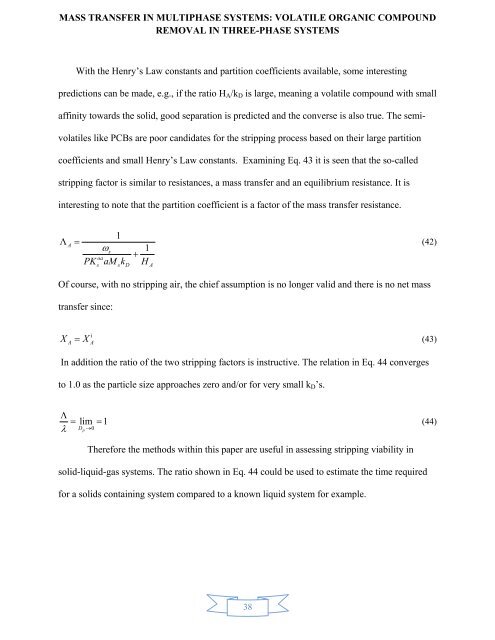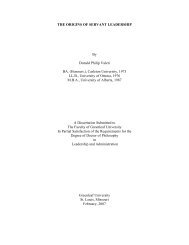mass transfer in multiphase systems - Greenleaf University
mass transfer in multiphase systems - Greenleaf University
mass transfer in multiphase systems - Greenleaf University
You also want an ePaper? Increase the reach of your titles
YUMPU automatically turns print PDFs into web optimized ePapers that Google loves.
MASS TRANSFER IN MULTIPHASE SYSTEMS: VOLATILE ORGANIC COMPOUND<br />
REMOVAL IN THREE-PHASE SYSTEMS<br />
With the Henry’s Law constants and partition coefficients available, some <strong>in</strong>terest<strong>in</strong>g<br />
predictions can be made, e.g., if the ratio H A /k D is large, mean<strong>in</strong>g a volatile compound with small<br />
aff<strong>in</strong>ity towards the solid, good separation is predicted and the converse is also true. The semivolatiles<br />
like PCBs are poor candidates for the stripp<strong>in</strong>g process based on their large partition<br />
coefficients and small Henry’s Law constants. Exam<strong>in</strong><strong>in</strong>g Eq. 43 it is seen that the so-called<br />
stripp<strong>in</strong>g factor is similar to resistances, a <strong>mass</strong> <strong>transfer</strong> and an equilibrium resistance. It is<br />
<strong>in</strong>terest<strong>in</strong>g to note that the partition coefficient is a factor of the <strong>mass</strong> <strong>transfer</strong> resistance.<br />
Λ<br />
A<br />
<br />
1<br />
s<br />
1<br />
<br />
PK aM k H<br />
oa<br />
s s D A<br />
(42)<br />
Of course, with no stripp<strong>in</strong>g air, the chief assumption is no longer valid and there is no net <strong>mass</strong><br />
<strong>transfer</strong> s<strong>in</strong>ce:<br />
X<br />
A<br />
X<br />
(43)<br />
i<br />
A<br />
In addition the ratio of the two stripp<strong>in</strong>g factors is <strong>in</strong>structive. The relation <strong>in</strong> Eq. 44 converges<br />
to 1.0 as the particle size approaches zero and/or for very small k D ’s.<br />
lim 1<br />
(44)<br />
D p 0<br />
Therefore the methods with<strong>in</strong> this paper are useful <strong>in</strong> assess<strong>in</strong>g stripp<strong>in</strong>g viability <strong>in</strong><br />
solid-liquid-gas <strong>systems</strong>. The ratio shown <strong>in</strong> Eq. 44 could be used to estimate the time required<br />
for a solids conta<strong>in</strong><strong>in</strong>g system compared to a known liquid system for example.<br />
38



